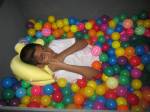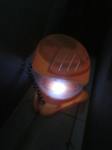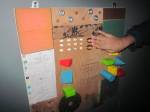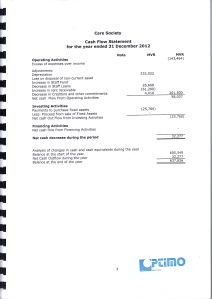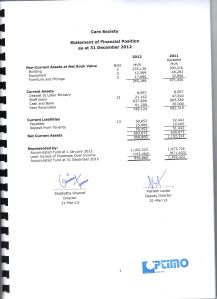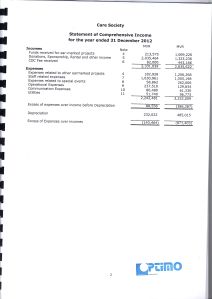Posted on: March 6, 2012
- A student at CDC experiencing the ball bed; Ball bed provide a sensation of calming and relaxation and it is visually stimulating
- Different textures of mats provide sensory stimulation of touch and feeling
- The sense of smelling is one sensation that calms and relax many children with disabilities. It gives a sense of familiarity and happiness for the child
- Touch board provide a range of textures for sensory stimulation of “touch”. Often used for children with autism, visual impairment as a source of learning and development
- Visual stimulation by moving objects in a dark room
Early Sunday morning when the students started arriving at the centre they did not know it is going to be a very different day for them. They had no idea that they will get an opportunity to explore a different environment and learn through their senses. When time came for Sanan to go into the class, he was feeling very reluctant. Holding the hand of the teacher he communicated using body language that he did not want to go in or have anything to do with this room. Through different motivation and physical prompt sanan entered the room. Slowly he got adjusted to the different aspects of it. The balls in the ball bed looks extremely colorful. The moving colors are very eye catching. The swing has its own wonderful motion. He can throw ball and make the wind chime dance. There are several mats on the floor that have all these different textures. Though sometimes ticklish; he enjoyed every bit of it. Seeing these colors, hearing these sounds, feeling these textures and motions are extremely self soothing and calming. And definitely Sanaan will have a good time here that will benefit his development. Sanaan is one child who benefits from the special education program carried out at the Care Development Centre and he is now getting more opportunities for development with the establishment of a sensory room. There are many other students studying at CDC who are getting similar support.
Children grow in a very unique and amazingly beautiful manner. Every child differs in his or her development. While many children might stick to the norms of developmental milestones some deviate from this either by being fast or slow. Regardless of the development all children should be provided with love, support and necessary stimulation that will enhance their growth and development. Even when working with a child with disability these stimulations are equally important. However they may differ in their responses to different stimuli and may require more support in some areas. As some children might dominate hearing or touch, others may dominate taste and sight.
Sensory integration is an important aspect of development for children with disability. At Care Development Centre, sensory games and stimulation exercises are often used to motivate and develop these senses. Sensory games are based on the aspect that sensation is how the child learns their environment. A special tool used in many special education centers is sensory room. It can be either calming or energizing or multipurpose.
A sensory room is a place where children explore and develop their senses and skills. It may have different feature like soft play, padded floors and walls, interactive equipments that makes dramatic changes to the sensory room environment using sounds, lightening and fragrancing.
Children process, interpret and respond to sensory information daily. While sensory integration games are largely intended to benefit children with sensory processing disorders, all children can benefit from sensory-rich games. A sensory-rich environment provides fun learning opportunities for all children. The purpose of having a sensory room in Care Development Centre is to create successful sensory integration games, allow students to choose from a variety of activity options that would enhance their development.
Sensory Room for Sensory Integration
Disability Awareness Workshop for Parents and Pre School Teachers of Naifaru Noorani Pre School
Posted on: April 16, 2013
This field trip was organized as per a request from the local NGO Naifaru Juvenile. The purpose of the trip was to conduct awareness sessions for parents and Pre School Teachers. Two facilitators from Care Society went to Naifaru to conduct the sessions from 11th to 13th April 2013.
The trip was funded by NGO Naifaru Juvenile.
The workshop started on the night of 11th April 2013, with an introductory ice breaker which was then followed by awareness sessions on UN Convention on the Rights of Persons with Disability and the Disability Act of Maldives.
On 12th April 2013 afternoon sessions were conducted on the terminologies used to refer to disability, the different kinds of disabilities and different ways that parents and teachers could possibly work with persons with disabilities. In the evening sessions, information was provided for the participants on the different services available in Maldives for PWDs. Also, a small evaluation was done in order to determine how much the participants gained from the sessions.
Teachers and parents recognized the need of having more awareness session, particularly for PWDs and their families. The teachers requested to conduct a special training program for them in order to equip themselves with necessary techniques to work with children with disabilities.
41 participants joined for this workshop .
Naifaru Juvenile is a very strong willed NGO wherein they do a lot for the local community to empower its youth, women, children and other groups. This is an ideal community where we can explore the possibility of implementing a Community Based Rehabilitation program.
The team from Care Society returned to Male’ on 13th April 2013.
Written by: Aishath Sufana
Children with Autism communicate many of their needs through different behaviors. Often the consequence of their action is getting “what they want”. Targeting the consequences and changing it would intern effect the behavior of the child. Consequence is what happens right after a behavior. It can be fulfilling a biological need, psychological need or materialistic need. Like we can control the triggering factors we can control the consequences of the actions,
Example: Aisha saw a beautiful toy on the shop while she was coming home with her mother. Aisha demanded her mother to buy the toy for her. When her mother said NO, she started crying and screaming. Then Aisha’s mother bought the toy for her and she stopped screaming and crying. The consequence of Aisha’s action is “getting the toy she wants”. Hence the chances are that Aisha’s screaming or crying behavior will increase in future. Because she is getting what she want by exhibiting a negative behavior.
Scenario modification: Aisha Sees a toy she likes (actecendent)= Aishath Screems /Cry (behavior) = Mother ignores (consequences)
In this Scenario Aisha is not getting what she wants hence chances are her behavior (screaming /crying) will decrease. However when we start to work with a child this change will take time to be evident enough to make a behavior change. In real life such behaviors would not occur over one incident. It might have taken several such incidences for a child to come to an understanding that they can get what they want by crying or screaming. Hence when we start a behavior modification program and focus on changing the behavior by modifying the consequences chances are that the child might exhibit several other negative behaviors before the behavior is changed as demonstrated below.
Aisha Sees a toy she likes (actecendent)= Aishath Screems /Cry (behavior) = Mother ignores (consequences)= Aisha Hits her mother= Mother ignores= Aisha show a temper tantrum= mother ignores and take her home= aisha cries at home= mother ignores
As we can observed aisha’s behaviors has not changed even when she did not get what she wanted. This is because it will take time for Aisha to understand what is happening. She would have to come to a realization that regardless of her negative behavior she is not going to get what she wants. And eventually she would reach there after several trials. As demonstrated below.
Aisha Sees a toy she likes (actecendent)= Aishath Screems /Cry (behavior) = Mother ignores (consequences)= Aisha Hits her mother= Mother ignores= Aisha show a temper tantrum= mother ignores and take her home= aisha cries at home= mother ignores= Aisha Stops crying=mother ignores= Aisha Attends to something else at home (acceptable behavior)= mother gives a hug
Hence, behavior modification is an achievable task with proper understanding of the Childs behavior and dealing with it consistently. Once it is decided to not give any reinforcement for a negative behavior then it is important to stick to that decision otherwise it would be a never ending challenge to deal with them. And because of this the child may face different challenges in functioning within the society.
Autism Awareness month
Posted on: April 7, 2013
Intervening behavioral problems at home: Working with children with Autism
One of the main features of children with autism is their lack of communication or speech delays. Due to this many of their needs, emotions and thoughts are not communicated well. Some children often find it hard to make others understand their wants. Hence such frustrations or difficulties are exhibited in the form of different behavioral problems. Addressing to behavioral problems is crucial in development of children with autism. This would enhance their participation, social functioning and learning. Though behavior modification and therapies are professional interventions parents can also play an important role in implementing such programs. There are many things parents can do at home. This article looks at one aspect of behavior modification.
Identifying the reason for the behavior
Identifying the reason behind a certain behavior can also be referred to as triggering factors or antecedents. When we understand these factors we are able to mold or change the outcome by changing the triggering factors.
Triggering factors can be biological such as thirst, hunger, and sleep deprivation, less energy or hyperactivity. It can be environmental such as temperature (too hot or cold), crowded environments, too loud and not enough play materials. It can be social/ interpersonal such as argument with family members, misunderstanding and lack of personal space.
Example: Aisha did not get her favorite roshi for breakfast instead she was given bread. Aisha started screaming so loud and the parent took her to her room till she stopped screaming. In this example the reason for screaming is because Aisha loves roshi and that is what she has for breakfast every morning. Since children with autism have difficulty in accepting such changes in routine, Aisha would not understand why she had to eat bread instead of roshi and neither can she communicate how she feels or what she wants. The only way Aisha knows how to deal with it is by screaming.
Now that we know Aisha finds it difficult to adjust to changes we can control the triggering factors. For one thing it is important to always keep roshi for breakfast to avoid the behavior of screaming during breakfast time. And a more practical approach might be to introduce different food along with roshi so Aisha might have variety of foods and eventually might start to like them too.
Hence, introduction of new concepts or changes to routine should be delivered slowly. Sudden changes might alarm them and it might be expressed through different behaviors.
It is important to note such observations and keep it for future references. The more you observe the child the more you will understand how you can help. It is not always easy to control the triggering factors. However, it is one way of dealing with different behavioral problems and making sure such interventions are well planned with the help from professionals and the consistency in delivering is the key for success.
Written by Aishath Looba
Launching of “CBR – Handbook”
Posted on: April 1, 2013
Community Based Rehabilitation – “Reducing the impact of disability for an individual, enabling him or her to achieve independence, social integration, a better quality of life and self – actualization.”
Care Society is a local non-government organization working with the aim to improve the lives of people with disabilities in Maldives. Disability services have grown since the founding of Care Society in 1998, with many services centralizing in the capital city, Male’. However the majority of the population lives in the outer atolls of Maldives where access to services and facilities are very limited.
Rehabilitation : Rehabilitation includes all measures aimed at reducing the impact of disability for an individual, enabling him or her to achieve independence, social integration, a better quality of life and self – actualization. Rehabilitation can no longer be seen as a product to be dispensed; rather rehabilitation should be offered as a process in which all participants are actively and closely involved.
What is Community Based Rehabilitation (CBR)?
Community Based Rehabilitation (CBR) is a strategy within general community development which aims to deliver rehabilitation services in less developed countries. CBR programmes see the need to change attitudes and behavior and promote social inclusion, to make services accessible and remove barriers to equalization of opportunities.
Why CBR?
Institutional Rehabilitation provides excellent services to address the problems of individual persons with disabilities and is often available only for a small number at a very high cost. Institutional overheads and other major infra structural expenses make the process very expensive. Moreover, the endeavor in an institution is often out of context to the felt needs of the people with disabilities, and thus falls short of their expectations. The fact that this person comes from a particular background and cultural setting is often ignored. The institutional culture is imposed on the person with disabilities and they are often expected to function as advised by the “experts”. In an institutional rehabilitation programme, the community is not linked with the process. Hence, when the person with disabilities return home, it may become difficult for them to integrate into their community.
Many institutions follow community-oriented approaches. In this method of approach, the services are provided at the level of community through an outreach clinic or camp based approach. The program is guided by the institution and directed by the availability of the resources. The patients and community are only the beneficiaries. e.g. as and when appliances like wheelchair, tricycle, or calipers become available, they get distributed whether it is appropriate or not. However, these strategies are inadequate to respond to the needs and expectations of the disabled and their community. Whereas rehabilitation based in the community ensures community participation, uses locally available resources and learns from existing innovative approaches in the community.
Community Based Rehabilitation is defined as a strategy within community development, for rehabilitation, equalization of opportunities and social integration of all people with disabilities.
Community Based Rehabilitation is implemented through the combined efforts of the disabled people themselves, their families and communities along with medical and other experts as appropriate, incorporating health education, vocational and social services (ILO, UNESCO & WHO, 1994, Community Based Rehabilitation – For and with people with disabilities – a joint position paper). Accomplishing this involves creation of awareness in the community regarding disability, value of disability prevention, and rehabilitation methods. In order to base the rehabilitation in the community it is of prime importance to inspire the community and recruit volunteers for this task. This is not an easy process. An education and training model was found to be a compromise approach, which is likely to succeed, as will be explained subsequently. The volunteers need to be trained to identify and intervene appropriately to deliver rehabilitation services in the community.
History of CBR in Maldives
With the support from various donor agencies, Care Society has been able to conduct CBR program in various islands in Maldives and form CBR groups in those target islands. In the year 2007, CBR of Maldives has been partnered with South Asian CBR Network and in 2009 partnered with Asia Pacific CBR Network, which are international networks working towards networking of all CBR activities in the field of disability. CBR Network uses Community Based Rehabilitation as a strategy to approach the community and the government for the rehabilitation and inclusion of persons with disabilities in all developmental programmes and protection of their human rights particularly to promote UNCRPD (UN Convention on the Rights of Persons with Disabilities). In 2011, representative from Care Society was elected as one of the executive member of the Asia Pacific CBR Network.
Care Society has conducted trainings in some islands to implement the CBR programs. To conduct center based activities two centers have also been established. One center is in South Huvadhoo Atoll Thinadhoo (Heeds Learning Center) and the other in Addu Atoll Hithadhoo (Association for Disabilities Rehabilitation Care). Also, CBR workshops have been conducted in North Thiladhunmathi Maarandhoo and South Thiladhunmathi Hanimaadhoo. In these workshops, CBR volunteers have been trained to carry out CBR related activities within the islands. However, the efforts to retain these trained volunteers have been a challenge Care Society has been facing for the past years. The difficulties faced include, issues with financing, lack of support from stakeholders and the lack of a physical structure to conduct CBR programs.
Conclusion
With the support from the stakeholders, Care Society hopes to improve the quality of life of person with disability and the sustainability of the CBR activities in the islands. Care Society also welcomes new approaches to build a better inclusive communities.
A handbook on CBR has been launched on the 28th of March by the former president of the Maldives, Uz. Maumoon Abdul Gayoom.
Other government officials, NGos, parents and students of CDC, with staff, volunteers and participants from the Disability Management Training participated.
The function was held at Asaree Maalam, and in his speech the chief guest suggested the importance of having statistics about disabilities in the Maldives and also highlighted the importance of NGOs working together.
With the launch of this handbook Care Society hopes that the work in this area will be more established and the book serves as part of the contribution to the area of disability in the Maldives.
Below we have included the contents of the handbook for our reference.
Table of Contents (Community Based Rehabilitation Handbook)
Introduction of the Manual
What is Community Based Rehabilitation (CBR) Program?
· CBR at Individual Level
· CBR at Community Level
· CBR at National Level
How to plan and execute a CBR Program
· Formulating a CBR structure
· System to run a CBR Program
· Sustaining a CBR Program
-Strong Leadership
-Partnership
-Community Leadership
-Utilizing Community Resources
-Adapting to the local culture
-Building the Community Capacity
-Fund Raising
-Government Support
Stages of Implementing a CBR Program
· Situation Assessment of the island to gather information
· Potential Stakeholders to partner with the CBR Program at Island Level with their roles indentified
-Persons with Disabilities (PWDs) and the role of their families
-The role of Volunteers of a CBR Program
-NGO participation & their roles
-Participation of Disabled People’s Organizations (DPO) & their roles
-Participation & roles of Government Organizations
-Roles of CBR Managers & Workers
· Services that can be provided through CBR
-Home Visiting
-Centre Based Activities
-Social Activities for Children & Persons with Disabilities
-Parent Support Groups
· Vocation Skills Building Program for PWDs
· Information on Disability
-What is Disability?
-Types of Disabilities seen in Maldives (signs, how to work with them)
-Skill Building through Play Activities
Annual General Meeting 2013
Posted on: March 25, 2013
The Annual General Meeting (AGM) 2013 was held at the STELCO auditorium on the 21st of March 2013.
A total of 63 invitees were present for the meeting including staff, parents, target members, resource members and officials representing various stakeholders of Care Society. The meeting was chaired by the vice chairperson of the Executive Board, Mr. Abdul Hameed Ali.
A summary of the Annual Report 2012 was presented including a recap of the most important events / tasks carried out in the year 2012. The presentation was made by Director, Ms. Shidhatha Shareef. Major challenges faced by Care Society were also highlighted in the presentation.
After the presentation by Ms. Shidhatha, Annual Report 2012 was endorsed by the executive board.
The presentation of the Audit Report 2012 was made by Assistant Director, Ms. Aminath Saleem. Annual Audit for 2012 was carried out by Mr. Shimad Ibrahim from the Optimo LLP auditing firm. The presentation precisely highlighted on the findings of the audited financial statement. Specific recommendations by the auditor were shared with the invitees.
After the closing remarks by the Vice chairperson, the meeting concluded with refreshments.
With all the hard work and hardships during the past couple of months in order to secure our future, it was a relief to finally celebrate something that we have been working so hard to sustain.
The 12th anniversary of Care Development Center (CDC)this year was marked on the 13th of March. The reason it was marked on this date this year is because, after 11 years of providing services as a higher education providing center, on the 13th of March 2012 CDC was finally registered as a special school.
It is with pride and pleasure that we mark the 12th anniversary of the only special school that caters for all types of disabilities in the Maldives.
The celebration constituted of a special assembly, where a couple of new ideas were introduced, and a party for all students of CDC and the staff was organized.
The assembly organized to mark this day was made special by the special guests; the Minister of Defense and National Security Colonel Retired Mohamed Nazim, Acting Minister of Gender, Family and Human Rights Uz. Azima Shakoor, State Minister of Education Mr. Imad Salih, and also the President of the Disability Council Mr. Ahmed Athif who made time out of there busy schedules to make the 12th anniversary of CDC a successful event.
At present CDC functions with 5 classrooms, 1 sensory room, 11 teachers in 3 sessions. The programs run at CDC aims to increase and develop the capacity of these few students who get the opportunity to attend school. As such on this occasion it was with anticipation and hope that CDC introduced its first prefect board.
The main purpose of introducing such a board in the school is to allocate responsibilities that can be manageable for the students attending the school and providing them with opportunity to take on leadership roles.
The next important event in the assembly was the introduction of envelopes made out of recycled paper. These envelopes are made by the students of CDC and will be used to send official letters of Care Society from this day forward.
To increase and provide opportunities for the students, these envelopes will be available for other interested parties as well.
All the special guests were given the opportunity to address the students, parents, staff and volunteers who attended the assembly.
The Minister of Defense and National Security, in his speech called on volunteers to contribute to Care Society to support the wok done in the field of disability. He also donated a gift to the students of CDC.
In her speech the Acting Minister of Gender, Family and Human Rights Uza.Aishath Azima Shakoor highlighted that the government will be exploring opportunities from International Organizations to provide assistance to Care Society in the future.
The assembly ended with new hope and new responsibilities for the students who received the badge of prefect – hood and students who didn’t receive it to work towards it.
The following day was a fun day for students as they came to CDC to party. They had games and fun activities organized with music.
http://www.flickr.com/photos/nazeeh/8553709147/in/photostream/lightbox/
1998
Care Society was established as a non-governmental organization (NGO)
Field of Concentration
Advocacy, service delivery and community development in the Maldives.
Our objectives
- Promote rights of people with disabilities
- Promote rights of children and women
- Building capacity of civil society organizations including Community Based Organizations
- Assisting survivors of natural disasters like tsunami
2001
Care Development Center (CDC), a special school as established.
45 students currently receiving direct services
Age range 0-25 years
Main Objective
Provide rehabilitation services to persons with disabilities. The students catered at CDC ranges from the ages of 0 – 25 years and currently 45 students are receiving direct
services from CDC.
2002
Community Based Rehabilitation (CBR) program
CBR centers established in; S. Hithadhoo, GDh Thinadhoo and Gn. Fuvamulah
Main Objectives
- Deliver rehabilitation services in the islands.
- Address the need to change attitudes, behaviors and promote social inclusion
- Make services accessible and remove barriers to equalization of opportunities.
Disability services have grown since the founding of Care Society in 1998, with many services centralized in the capital city, Male’.
Current situation:
2002
A 5 story building in M.Fiyaathoshimaage
Work in the new building established
4 floors from the building under the ownership of CS for the agreement period (till 7th June
2013)
2 floors utilized to raise funds (contribute towards the running of CS by renting out as
apartments).
2 floors utilized to provide direct service to people with disabilities (PWD’s)
BY
2013, 7th June
Care Society has to renovate M.Fiyaathoshimaage and building handed over to the owner
AFTER
2013, 7th June
Owner agreed to rent first 2 floors (only) to Care Society till end of 2013
For a rent of MVR 48000 per month (Rent period June – December 2013)
WORK DONE TO SECURE A PREMISE FOR CDC
Seeking Options
Main focus
Requesting government to provide a space to run the special education school- Care
Development Centre
2008
Meetings with different government agencies;
Minister of Education
Minister of Gender, Family and Human Rights
The President’s office
Meeting with former president His Excellency Maumoon Abdul Qayyoom
2009
Meeting with Former president Mr. Mohamed Nasheed
Opportunities
2009, 23rd January
In the function held to mark the 10th Anniversary of Care Society former president Mr. Mohamed Nasheed promised a building
2010, 1nd February
Care Society signed an agreement with Ministry of Finance and treasury.
The agreement
H. Sea View for a rent of MVR 500 per month
For a period of 5 years (which Care Society has been paying till date).
Challenges
H. Sea View is an old building which has to be completely demolished and reconstructed
2009, 6 April
Approached former president Mr. Mohamed Nasheed for a functional premise
Outcome
Government cannot support construction
Care Society should have to raise funds
2011, 5th February
Zonal Construction developed a BOQ (free of charge)
For construction of a 2 story multi-purpose building
2011, March – August
Meetings several private companies and business personnel requesting for Funding
RCNC and RYAN agreed to help; conditioned that Care Society extend the agreement
period to minimum 20 years
2011, 26th June and 10th July
Requested the Ministry of Finance for an appointment
Exploring the options to extend the rent period and allowing to rent out floors to cover the cost of
construction
2012, 6th June
Developed a proposal for the building. (10 story building)
2012, 14th June
Proposal sent to Ministry of Finance and the President’s Office.
Further work
2012, 5th June
Meeting with President’s Office
2012, 5th June
Vice President Mr. Mohamed Waheedhudeen visited H. Sea View
Noted that the place is not appropriate to run a center for PWD’s.
2012, 9th September
President’s Office requested to submit the proposal to Ministry of Housing and Infrastructure
2012, 11 September
Proposal sent to Ministry of Housing and Infrastructure
2012, 19th September
Meeting with Minister of Housing and Infrastructure
As requested by the Minister of Housing and Infrastructure the proposal was revised to a 5 story building
The building would only be used for activities of Care
No opportunity for generating funds
2012, 21st October
Proposal sent
2012, 5th November
Housing Ministry sent a letter to Care Society
The time period extended for 20 years
2012, 23rd December
Ministry of Housing and Infrastructure has requested to Ministry of Finance to extend the
agreement date
CS was asked not to do any work that would extend beyond the period of 5 years
Ongoing work
Individual Meetings with relevant government ministries and commissions
2013
23rd January
Meeting with Minister of Finance
29th January
Meeting with Minister of Education,
Meetings with Human Rights Commission
7th February
Meeting with Disability Council
Role of Donors
The most important role in survival of any NGO
Care Society depends on different types of donors for it’s sustainability
Private sector is obligated to provide funding to social sector as part of their cooperate social
responsibility
However this is not practiced in many companies and cooperation’s.
No sustainable government funding is diverted towards NGO sector unlike many other
developing countries
Approaching Donors
2013
30th January
Meeting with MNDF to assist in fundraising
5th February
Meeting with owner of Souvenir requesting for inancial support
Requests sent to meet
Mr. Buruma Gasim (Villa)
Mr. Waheedhudheen (Bandos)
Mr. Shiyam ( Sun Travels)
Champa Foundation
Muni Home care, Universals, Bright brothers, campus
Role of Media
Media can play a vital role in bringing issues to the public:
Share work done by Care Society and Care development Center
Give focus and attention to the crisis situation
Assist in seeking donors for Care Society (promoting the work done by Care Society)
Approaching to media to identify their role
2013
31st January
Meeting with MBC
4th February
Meeting with Dhi TV
Meeting with Raajje TV
5th February
Meeting with Villa TV
We need any avenue of assistance we can get in order to survive and continue to provide education.
Community Based Rehabilitation – Training Workshop – GDH Thinadhoo 2012
Posted on: December 11, 2012
The purpose of the filed trip to Gdh Thinadhoo from 20th– 24th October was to technically train the Pre School teachers, CBR workers and the Community Health Workers to implement CBR activities in the island. This trip was funded by FIDA International, who is the main donor for the Community Based Rehabilitation works conducted by Care Society.
As part of the trip, Care Society’s team met with two members of the CBR team. The main objective of the meeting was to gather information on the current status of the CBR activities and to explain the new approach designed by Care Society to conduct centre based activities and home visits. In this meeting the new CBR Manager was introduced and briefed on the activities and programs carried out in the island so far.
The workshop to train the Community Health Workers and the CBR volunteers was held from 20th – 23rd October 2012. In this workshop, participants were given training on how to conduct home visits, how to plan and conduct centre based activities(targeting persons with disabilities), types of disabilities, communication skills and interviewing skills, how to form and conduct Parent Support Groups. A practical was done on conducting centre based activities. Also a plan of action was drafted to be implemented in the island, for the next three months.
10 participants achieved the certificate of completion during the closing ceremony. Responsibilities of other stakeholders were also identified and explained during the closing ceremony.
In the remarks given by the Chief Guest during the closing ceremony, mentioned that high importance should be given to advocate and create more awareness among the community on different issues related to disability. He also assured the participants of the training that the MM Pre School and Island Council will support them in facilitating any necessary arrangements for CBR activities.
Written by Aishath Sufana
Assistant Manager, CBR
CELEBRATING 14 YEARS OF DEDICATED SERVICE – Moving Forward More Diligently
Posted on: November 10, 2012
As we celebrate our 14th year of existence, we are proud to state that our work has expanded progressively with each passing year.
When Care Society came into existence, disability was a taboo in most of the households in Maldives, making it difficult for us to reach out and provide our services to the community. As we grew with each year we have been able to reach more and more people around the nation. Currently, we have more than 600 registered target members at Care Society.
After the 2004 tsunami, Care Society widened its’ services to include advocating for the rights of children and women, building capacity of civil society organizations including Community Based Organizations, and assisting survivors of natural disaster, while still the main focus remaining on persons with disabilities.
Throughout these 14 years we have reached several milestones in development, starting with Care Development Centre, the only rehabilitation and education centre established for people with disabilities being registered as a special school after 11 years of service in 2012. The Community based rehabilitation program initiated with two programs in Gdh. Thinadhoo and S. HIthadhoo has expanded its services to several islands in establishing awareness programs and community based programs targeting persons with disabilities. Capacity building of those involved in these programs is ongoing, with new people being trained each year to work with persons with disabilities at an island/atoll level.
Currently there are 47 persons with disabilities receiving direct intervention at Care Development Center with a total of 10 teachers working diligently with them and still there are a number of students waiting to get an opportunity to study at Care Development Center.
This year, to extend our services we have started a Home Based Program focusing on the registered people who are unable to join Care Development Center. This program concentrates on training the parents/ guardians of the person with disability to work with them at home with the guidance of case workers from Care Society. At present there are 4 persons with disabilities registered in the program.
With this year came the establishment of the HELLO Friends Club, targeting children between the age of 4 and 13 years. The club is designed to develop social skills through play, drama, music, art, craft and reading. The main purpose of this club is to support young children, families and communities to learn how to participate and integrate people with disabilities.
With our hard work comes the assistance of outsiders, who have become a part of Care Society through different avenues; as a volunteer, a member, a sponsor, or simply a well-wisher. Therefore on this occasion, as we celebrate our 14th Anniversary we would like to extend our heartfelt thanks to all of those who has helped us throughout our existence and hope that we will always be blessed to have you with us in the future.
Regardless of our huge success and hard work, challenges that we face are vast. We are still being confronted with a shortage of people with expertise in the area of disability and the lack of a better space to provide our services. Currently we are struggling to find a way to construct the new building, which will be a special education school for children with disabilities and hopefully to provide other opportunities for persons with disabilities.
It brings us great pleasure to say we kept on moving uphill for the past 14 years and will keep on moving forward towards “An inclusive community free of inequality”.
Written by: Safa Ibrahim
Edited by: Aishath Looba
